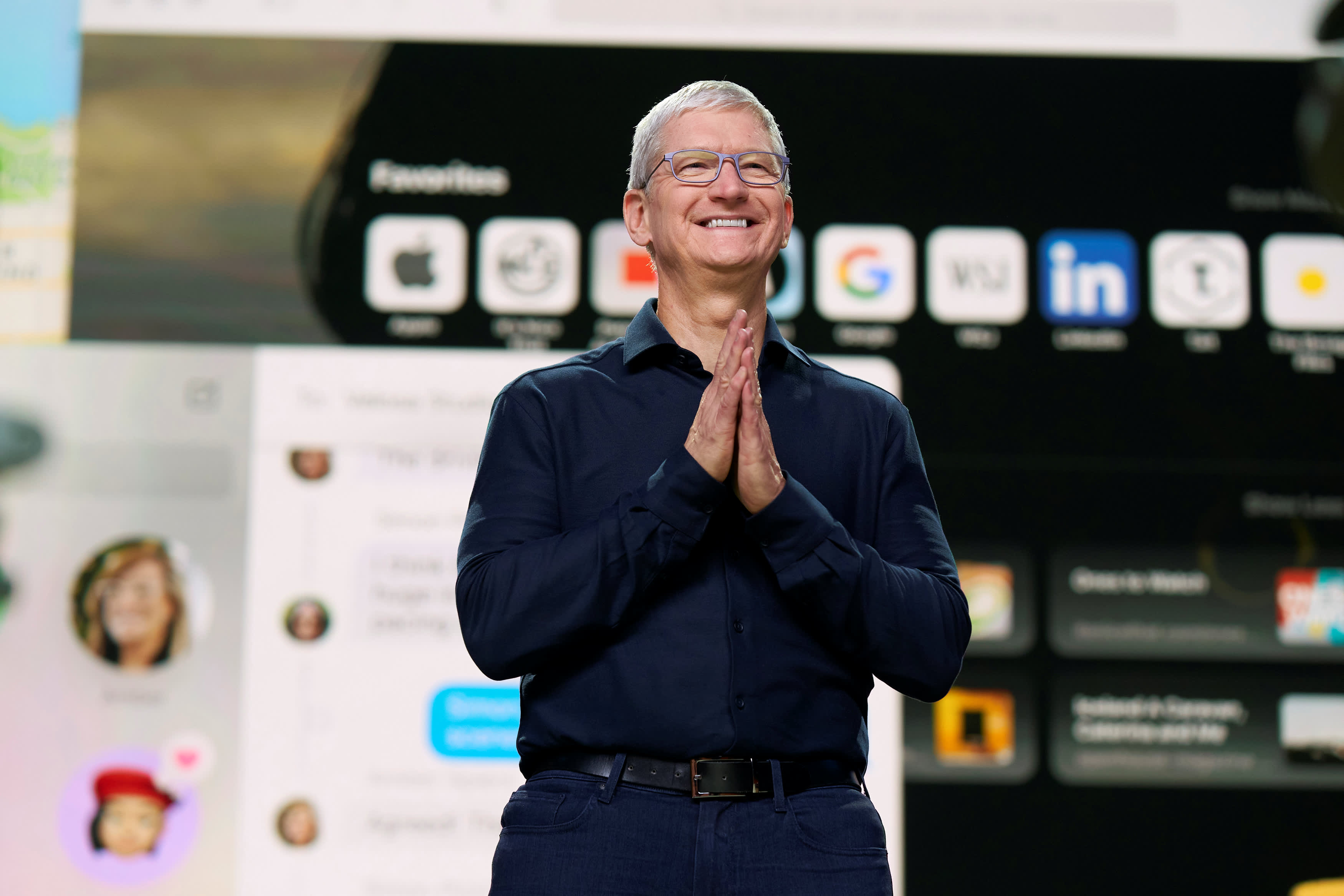Apple CEO Tim Cook delivers the keynote address during the 2020 Apple Worldwide Developers Conference at Steve Jobs Theater in Cupertino, California, June 22, 2020.
Brooks Kraft | Apple Inc. via Reuters
On Wednesday, Apple became the first $2 trillion U.S. company.
The iPhone maker’s share price hit $466.77 around 11am ET, sending it over the mark. It’s the most valuable publicly traded company in the world, beating out Saudi Aramco, Microsoft, and Amazon. Apple stock is up about 60% year-to-date. The milestone comes a little more than two years after Apple became the first $1 trillion company in August 2018.
While the mark is largely symbolic, it does underscore Apple CEO’s Tim Cook’s success at changing the company’s story. Investors have started seeing Apple’s business less like other hardware makers and more like a software company, as indicated by Apple’s quickly rising price-to-earnings ratio, which is now over 33.
“Over the past four months, the market has really been valuing Apple as a software company,” said Logan Purk, analyst at Edward James, who has a hold rating on the stock. “The services business is growing nicely — it seems to give them a multiple over 30, and gives them all the credit in the world for this subscription business.”
“They’re starting to get compared to some really big software heavyweights,” Purk added. Microsoft trades at a 36 PE ratio, and Amazon’s PE ratio is currently over 123.
Apple first started to refocus investor attention on its services business back in 2015, as iPhone growth first slowed.
Its definition of services includes a lot of different things: iTunes purchases, App Store fees, Apple Music, licensing, AppleCare warranties on hardware, and revenue from Apple Pay, among others. In the past two years, Apple has started to launch new subscription services to bolster the business, such as Apple News+, a digital magazine bundle, and Apple TV+, a competitor to Netflix and Disney+. Last year, Apple also introduced Apple Card, a credit card partnership with Goldman Sachs integrated into the iPhone’s software.
“The reason we’re talking about…$2 trillion when it feels like it was just passing $1 trillion is just how well they’ve done vertically integrating through their technology stack, starting with hardware, and then now moving into software,” Nick Grous at ARK Invest said. “When we think about Apple, long term, we may not be focused on what other analysts are focused on, being iPhone sales and device sales. We’re actually really focused on their services.”
In January 2016, Apple released new financials related to its services business, and Cook said: “I do think that the assets that we have in this area are huge, and I do think that it’s probably something that the investment community would want to and should focus more on.”
In 2017, Cook set an ambitious growth target for the business: Apple wanted to double its 2016 services revenue by 2020, which would put the goal at roughly $46 billion by this year.
It hit that goal six months ahead of schedule. In the quarter ending in June, Apple reported $13.16 billion in services revenue, accounting for about 22% of the company’s total sales.
Before Apple was able to get investors to look at it like a software company, its low PE ratio compared to big tech peers like Microsoft was an object of fascination for techies and investors. Investors saw its hardware business as “hits-driven” and worried that future iPhones and iPads might not sell as well as they had in the past. Venture capitalist Marc Andreessen remarked in 2015 that Apple traded like a “steel mill going out of business.”
According to Tom Forte, an analyst at D.A. Davidson, the triumph underscores Tim Cook’s unique strengths compared with founding CEO Steve Jobs.
“Steve Jobs famously would focus on, ‘our goal is to to determine the few things that we should do and do them as well as possible.’ And then because of the maturation of the smartphone market, I think that forced Tim Cook’s hand. He’s basically said okay, what is Apple good at? Now let’s apply that to a lot of different things,” said Forte. “And I think services is probably one have the best examples, meaning that Apple’s not just going to be a hardware company.”
Apple’s services business is still half the size of its iPhone business, and largely depends on it — many of Apple’s services, like its AppleCare warranties or App Store, are directly targeted at its existing base of 1.5 billion devices, not at the larger market of Android or Windows users.
Increasingly, the App Store, which is one of Apple’s most important and biggest services, is drawing criticism from developers who say its 30% cut on sales of digital goods is too rich. It’s also feeling pressure from lawmakers and regulators — Cook had to answer several questions about the App Store’s business practices at a congressional hearing in July.
Apple hasn’t yet provided subscriber numbers for Apple TV+, Apple News+, or Apple Arcade, which were launched in 2019.
There are other factors behind Apple’s rise. Tech stocks in general are doing well in the pandemic as investors search for safe havens that offer the possibility for growth. Apple is also a big purchaser of its own stock, authorizing a $50 billion increase to the company’s share repurchase program in 2020, following top-offs of $75 billion in 2019 and $100 billion in 2018.
Some investors are betting on a “hype cycle” this fall because Apple is expected to release an iPhone that connects to 5G networks which could increase sales, John Vinh, KeyBanc analyst, said.
But Apple’s rise to the ceremonial $2 trillion mark, doubling the company’s value in about two years, doesn’t happen without investors undertaking a major re-appraisal of the company’s business model.
WATCH: Tim Cook is ‘perfectly tuned’ for a post-iPhone Apple, says Roger McNamee
